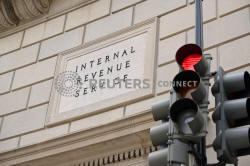Explainer: The $4 trillion U.S. government relies on
individual taxpayers
 Send a link to a friend
Send a link to a friend
 [September 29, 2020] By
David Lawder [September 29, 2020] By
David Lawder
WASHINGTON (Reuters) - The U.S.
government's over $4 trillion annual budget, the world's largest, relies
heavily on individual wage earners whose taxes and retirement benefits
are deducted from every paycheck, leaning particularly on the top 20% of
income earners.
Corporations pay just a fraction of what individuals do into the federal
spending pool, which funds the military, transportation safety, veterans
benefits, regulatory agencies and programs like NASA.
A New York Times investigation
https://www.nytimes.com/interactive/
2020/09/27/us/donald-trump-taxes.html published on Sunday shows that
President Donald Trump paid just $750 in federal taxes during the years
straddling his 2017 inauguration, and none at all for 10 of 15 years
before then. Trump dismissed the report as "fake news."
Trump reported
https://www.reuters.com/
article/us-usa-trump-ethics/trump-
owes-lenders-at-least-315-million-disclosure-shows
-idUSKBN1972XM income of at least $594 million for 2016 and early 2017
and assets worth at least $1.4 billion, in a financial disclosure in
June 2017.
HOW THE U.S. BUDGET IS FUNDED
Individuals, whether they are self-employed or earn a paycheck from a
small business or a giant corporation, foot most of the federal
government's bills.
Individual income tax funds U.S. federal spending: https://graphics.reuters.com/USA-TRUMP/TAXES/xlbpgjzwrvq/chart.png
Of the $3.46 trillion in receipts taken in by the U.S. Treasury during
fiscal 2019, nearly half came from the $1.72 trillion in individual
income taxes collected.

In addition, $1.24 trillion in Social Security and Medicare taxes were
paid by individuals, bringing their share to 85%.
Taxes paid by corporations last year totaled $230 billion, or just 6.6%
of the total in 2019. The remainder of federal revenues are made up from
customs duties on imported goods, excise taxes such as those on
gasoline, estate taxes and other miscellaneous taxes and fees.
WHO PAYS THE MOST?
W2 wage earners - those with a regular paycheck from a business,
government entity or non-profit - make up the largest share of tax
revenue through income tax and social insurance withholdings, like the
payroll tax that funds Social Security, the government retirement
program.
Those withholdings can reduce
https://www.taxpolicycenter.org/
briefing-book/how-do-federal-
income-tax-rates-work Americans' take-home pay by nearly 40%, depending
on income, and have made up about 73% of total revenue over the past two
fiscal years through August.
Despite high unemployment because of the coronavirus pandemic, withheld
income taxes in 2020 have fallen less than 1% from 2019 levels, partly
due to higher earnings early in the year and aid to small businesses
that kept paychecks coming to many idled employees over the spring and
summer months.
Self-employed people, including many business owners, and those paying
capital gains or other taxes not withheld from their paychecks, make up
the second-largest category, funding around 19% of the total tax revenue
during fiscal 2020 through August.
[to top of second column] |

The Internal Revenue Service (IRS) building is seen in Washington,
U.S. September 28, 2020. REUTERS/Erin Scott/

TAXES BY INCOME LEVEL
The U.S. tax system has been described as "progressive," meaning that the share
of taxes paid rises with income, through seven https://www.taxpolicycenter.org/briefing-book/how-do-federal-income-tax-rates-work
tax brackets.
The very poorest, those making under $9,875 a year, are taxed at a 10% rate,
while the wealthiest, or those making $518,400 and over are taxed at a 37% rate.
But what the wealthiest pay is often much lower due to a variety of complicated
tax loopholes, which can benefit hedge fund managers, private equity firm
partners and real estate investors.
The 2017 tax cuts passed by Republicans and signed by Trump largely kept that
relationship intact, but shifted more of the tax burden to wealthy and
upper-middle-class wage earners. But income deductions for mortgage interest and
state and local taxes paid, the biggest middle-class tax breaks, were reduced
considerably.
A pre-pandemic Congressional Budget Office estimate
https://www.cbo.gov/system/
files/2019-12/55941-CBO-
Household-Income.pdf projected the top 20% would pay 69.7% of federal taxes in
2021.
U.S. federal taxes paid by income group: https://graphics.reuters.com/USA-TRUMP/TAXES/oakpeexxbpr/chart.png
America's 37% top marginal tax rate is lower than the top rates for many wealthy
and developing countries, including the OECD average of 41.2%, according to
https://home.kpmg/xx/en/
home/services/tax/tax-tools-
and-resources/tax-rates-online/individual-
income-tax-rates-table.html KPMG.
Corporations got a major tax cut in the Republican bill, when their tax rate
before deductions was slashed to 21% from 35%.
IS THE UNITED STATES COLLECTING ENOUGH TAX?
No. Even before the coronavirus pandemic sparked a deep recession this year, the
federal budget deficit https://fiscal.treasury.gov/files/reports-statements/mts/mts0919.pdf
in fiscal 2019 was $984 billion and was forecast in January to top $1 trillion
in fiscal 2020, which ends on Wednesday.

Massive spending to keep businesses and households from collapsing is expected
to drive the fiscal 2020 deficit to $3.3 trillion, dwarfing the previous record
of $1.4 trillion in 2009 and making up the largest share of gross domestic
product since the end of World War Two.
If action is not taken to shrink deficits in future years through spending cuts
or tax increases, the CBO has warned that federal debts as a percentage of GDP
will double by 2050.
(Reporting by David Lawder; Editing by Heather Timmons and Peter Cooney)
[© 2020 Thomson Reuters. All rights
reserved.] Copyright 2020 Reuters. All rights reserved. This material may not be published,
broadcast, rewritten or redistributed.
Thompson Reuters is solely responsible for this content.
 |